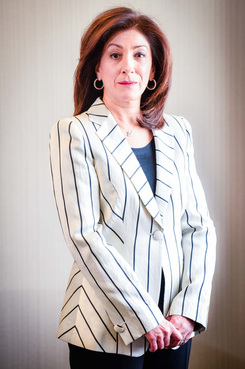Can Cravath and Wachtell's Lean Lockstep Approach Keep Them on Top?
Despite mounting challenges, the firms are more profitable than ever. But success is no longer a guarantee, as competition grows and firms like Sullivan & Cromwell prove lockstep pay isn't fundamental to high performance.
April 23, 2019 at 09:47 AM
14 minute read

Global M&A deal volume reached nearly $4 trillion in 2018—a hot year for the most lucrative practice at elite law firms. For two of those firms, Wachtell, Lipton, Rosen & Katz and Cravath, Swaine & Moore, the boom pushed profits per equity partner to new heights—$6.53 million at Wachtell and $4.62 million at Cravath.
Wachtell and Cravath remain small compared with their mega firm competitors, helping them boost profits even more. Wachtell, with 267 attorneys last year, and Cravath, with 519, each operate largely from a single office, setting them apart from the other Am Law 100 regulars in the M&A league tables.
 Leverage the Am Law 100 data with firm comparison and key performance data, exclusively on Legal Compass. Access Premium Content
Leverage the Am Law 100 data with firm comparison and key performance data, exclusively on Legal Compass. Access Premium Content Other key traits have become part of their legacies, defined their brands and perhaps fed into their success: They each have a one-tier partnership; they rarely hire laterals (and when they do, it's not to gain a book of business); and they utilize a traditional lockstep compensation model to pay partners by seniority.
Wachtell and Cravath have retained their twinned models amid increasing competition with global firms, which are betting on scale and lateral hires to gain more market share—often with stunning success. In the last decade, firms with competing M&A practices have approached or sailed past 2,000 attorneys. Several of these competitors are growing their presence outside the United States, offering a one-stop-shop model for global clients.
Meanwhile, Cravath and Wachtell still have their usual competitors on Wall Street. Sullivan & Cromwell, for example, has more than 800 attorneys and 13 offices and continues to rank high in deal volume, proving that a moderate growth strategy on Wall Street—without lockstep—can be just as successful.
Cravath and Wachtell's ability to remain prosperous in an industry shifting in other directions is a testament to the models they've built, but as the challenges before them mount, their continued success, once as certain as their clearly defined structures, is no longer guaranteed.
Ask Cravath or Wachtell why they chose their lean strategy and the key word is quality—implicitly suggesting their larger competitors are at a disadvantage.
"Our approach works for us and our clients, and it hasn't held us back," Wachtell partner Edward Lee says. "If you look at our experience, you will see a very significant portion of our business is cross-border. We have a truly global practice and we think New York is the ideal center from which to operate across the world."
Adam Emmerich, another Wachtell partner, says the firm believes its "one-office, one-team, collaborative approach," working with other lawyers around the world, "has been a tremendous advantage" for clients.
Even with just one office, the bulk of Wachtell's M&A practice consists of representing principals in deals, as it doesn't seek out representing banks in transactions—typically a plum spot for a firm. Wachtell ranks first in Bloomberg's 2018 league tables in representing principals in global announced deal volume. (As a comparison, law firms representing financial advisers in a deal earn a fraction of the legal fees.)
With their relatively small footprints and their lack of lateral hires, both Cravath and Wachtell have traditions of deep investment in associate training. (They compensate associates similarly, though Wachtell is slightly above the market set by Cravath, paying first-year associates $195,000 to Cravath's $190,000.)
 Faiza Saeed
Faiza Saeed"Our whole model is built on the importance of the entire platform," Cravath's presiding partner, Faiza Saeed, says. "You can always have some high-quality individuals, but consistency across a platform requires an incredible amount of effort and investment, and that's what we think of as our brand value."
"You sacrifice consistency across the platform if you grow too fast, and it's very difficult to do that kind of investment at a large scale," she adds.
Over time, the firms have doubled down on their single-office strategy. While Cravath has a few partners in a London office, it closed its Paris and Hong Kong offices years ago. Cravath previously had a Washington, D.C., outpost, which spun off to become a predecessor firm of Wilmer Cutler Pickering Hale and Dorr.
Wachtell has previously considered other locations, including London. It had a small office in Chicago, but closed it about two decades ago, according to John Coates, a former Wachtell partner who teaches corporate law and M&A at Harvard Law School.
Saeed says she doesn't ever see Cravath, which is celebrating its 200th anniversary this year, practicing anything other than U.S. law. But legal market observers continue to question the firm's plans on the West Coast, where significant work has emerged, including deals involving Disney, Dreamworks and Starbucks, and litigation for PG&E and Qualcomm.
"We're very, very present there, without being physically present there with an office," Saeed says. But she won't comment on whether the firm will open a California office in the near future.
Without a far-flung partnership, Cravath and Wachtell grab cross-border deals by leaning on long-standing networks with local counsel in other jurisdictions.
When Cravath advised Disney on its acquisition of Twenty-First Century Fox, including the battle over British broadcaster Sky, the firm worked closely with Slaughter and May in the U.K.
"It's just one example how on really critical, bet-the-company-type matters, we feel as comfortable with those relationships as we do with our partners," Saeed says. "There's probably no jurisdiction in the world where we don't have a very good relationship—that is a lawyer we actually work with and know very well.
"We think we deliver the best value to our clients when we can say, 'We're not trying to get you to use our partner in London or Paris because it's someone we acquired when we were growing the firm's footprint, but, rather, we're going to get somebody like us in that country," she adds.
 Adam Emmerich
Adam EmmerichSimilarly, Emmerich says Wachtell works with firms it has "long-standing relationships with," as the need arises. "We think that working in partnership with the best firms around the world, when transactions demand that, is the best solution for our clients. We are able to assemble the best team, with the most relevant experience," he says.
Wachtell's connections with overseas firms remain strong partly because those firms don't consider it to be a business threat on other matters. Coates, at Harvard, says he sometimes poses a question to law firm partners who attend his seminars: If their own firm had a conflict on a client matter and had to refer it to a global firm or Wachtell, which would they choose? "They always pick Wachtell," he says, because they believe the firm won't try to take the whole client relationship.
Partners at Cravath and Wachtell believe a key part of their firms' success is their lockstep system, which doesn't factor in business generation.
"Being a smaller, collegial group of partners, not competing with each other, is a benefit to our clients," Emmerich says.
"We're all rowing in the same direction," Lee adds. "There's no internal conflict around credit."
To Saeed, Cravath's system is results-oriented.
"Incentives work, so whatever behavior you incentivize, you get more of," she says. "We want people to focus on the work product."
But even these elite firms face pressure to tweak the model. The way Saeed explains it, competition for client relationships and high-value work has led to more lateral hiring, leading to more pressure on lockstep firms.
"That has created a bit of an arms race in terms of partner comp," she says. "What used to be a focus on rainmaker comp associated with an actual book of business has turned into comp for journeymen partners."
After longtime Cravath partner Scott Barshay left in 2016 for Paul, Weiss, Rifkind, Wharton & Garrison, his new firm, which paid him at least $10 million last year, handled one of 2018's largest announced deals, IBM's acquisition of software firm Red Hat. IBM has long been a Cravath client.
When asked about these circumstances, Saeed says, "Any time a partner leaves, there's always going to be the potential that a relationship that they were given while they worked here is also going to be a personal relationship. We aim to help our young partners build those relationships."
Don't expect Cravath to change its practices as a result of the Barshay move or others.
"As a business," she says, "you can't alter the way you do the things that have been a reason for your sustained success in response to an incident here or there."
Saeed says the firm's partners during her time as presiding partner have never considered modifying the lockstep model. But it has been evaluated.
"What are the behaviors we want to incentivize and do we have the right model in place to incentivize those behaviors?" she says, explaining the firm's thinking.
In her own work as an M&A lawyer, the complicated deals she handles rely on the firm's platform. "I don't think we would have a fraction of the quality or the work product we deliver" under another system, she says.
Saeed says she isn't aware of any upcoming partner exits, but she doesn't lose sleep over it either. When a partner doesn't share the firm's values, it's better for both sides to move on, she says.
In the last decade, compared with its lockstep peers, Wachtell has seen exceedingly few partner exits. One factor—besides the high profits—may be the firm's very narrow focus on M&A. The wider variety of practices at other lockstep firms exposes them to partners whose ambitions and specialties lead to opportunities elsewhere, Coates says.
To firms on the outside of the lockstep system, its benefits are exaggerated, and can, in fact, be weaknesses. Sullivan & Cromwell partners, in particular, attribute some of their success in retaining partners to their merit-based, black-box pay model.
"The perception among partners is that it's a broadly equitable pay system, and it provides the flexibility to pay people consistent with the effort they're putting out and the contribution they're making to the firm's practice and to the client," Joseph Frumkin, managing partner of Sullivan & Cromwell's M&A group, says.
"Clearly they are not leaving for monetary reasons," M&A partner Francis Aquila says of departing partners. Partners leave for great opportunities, he says, noting Jay Clayton's exit to lead the U.S. Securities and Exchange Commission and Karen Seymour's exit to become general counsel at Goldman Sachs.
Sullivan & Cromwell is an instructive counterpoint to Wachtell and Cravath's arguments. Its most recent office opening was Brussels, in 2017, when it hired Michael Rosenthal from Wilson Sonsini Goodrich & Rosati. Rosenthal was brought in to meet demand for merger clearance expertise post-Brexit.
The firm's strategy appears to be working: It was ranked among the top five M&A advisers in several league tables in the last two years, and its revenue and profits continue to climb. Its middle-ground growth strategy, Frumkin says, "was chosen as a way to maintain quality and focus in a way that becomes harder as you get bigger." It also allows the firm to have the geographic and practice area breadth that clients want—and that the firm finds helpful in executing transactions.
While Sullivan & Cromwell is growing outside the U.S., it also maintains a close equity partnership, bringing in few laterals.
"Could we make money by bringing in some high-profile lateral? Yes, we probably could, you attach the Sullivan & Cromwell brand to talent and you could figure out a way to make money on it, but it's not what we're about," Frumkin says.
The firm's partners point to their close collaboration on deal work to reject the notion that lockstep produces better results.
"Nobody survives here for a minute," Frumkin says, "thinking some client is their client and not S&C's client. No matter how big your ego is, if you can't figure that S&C is more important than any of us individually, you're not going to last here."
Aquila says one client recently told him she felt fine calling up any one of his partners in other practices.
"There was no perception that everything had to go through me or anyone else," he says.
M&A work is multidisciplinary, Aquila says, bringing in attorneys who handle intellectual property, litigation, antitrust, tax and more. Kim Rucker, a former general counsel of Andeavor, Kraft and Avon who sits on the board of three public companies, worked with Sullivan & Cromwell on two large transactions. She's relied on her relationships with other large firms, too. She seeks outside counsel that can pull together a high-quality team involving lawyers from multiple practices. In this respect, she says Sullivan & Cromwell is "incredibly collaborative."
A senior in-house lawyer who recently worked with Cravath on a large deal and who spoke anonymously because he couldn't speak for the company says the primary factor in retaining Cravath was its long-standing relationships with senior partners.
"That's really what drives things, rather than the size of their offices and how many offices they have. People can get on airplanes," the in-house counsel says. "It really is about the quality of the general, rather than the size of the army."
There are some exceptions to that rule, he says. For example, when choosing between two firms in a beauty contest in which the company has no prior relationship with either firm, offices in local jurisdictions for due diligence would be an advantage, to save time and resources. That's not the only potential disadvantage for leaner firms.
One of the biggest challenges that single-office law firms face, Coates says, is getting a share of the increasing amount of M&A originating from growing economies in Brazil, Russia, India, China and South Africa. Those countries are becoming increasingly important to the global economy, and thus more important to the legal market, he says.
"If the client is based in that jurisdiction, having a local office is a huge advantage," he says.
Top M&A firms—including Skadden, Arps, Slate, Meagher & Flom; Kirkland & Ellis; Latham & Watkins; Davis Polk & Wardwell; Simpson Thacher & Bartlett; and Sullivan & Cromwell—have invested in offices in one or more of these areas.
Meanwhile, as the Barshay move demonstrated, business can also peel away as a result of the lockstep model. That's because corporate counsel are guided by personal relationships.
Rucker, the former GC, says if a trusted adviser changes firms, moving work to the new firm would be a consideration, as would the quality of its team.
M&A is a small world, Coates says, noting that law firm partners often work with professional bankers who are sources of secondhand referrals. And board members at public companies often lead their own companies.
"The brand helps—it's easy to explain to boards of directors," he says, but "the principal driver of all legal engagements is personal or secondary relationships."
The in-house lawyer who recently worked with Cravath says if the company's relationship partner moved to a competitor, the company would likely go with the partner. "Our relationship is with him, not the institution," he says. "We hire lawyers, not the firm."
As long as clients think that way, losing an important partner in a lateral move will quickly translate to a loss of business. But Wachtell and Cravath's continued success suggests another lesson: A client's deep personal ties to a senior partner can allow lean lockstep firms to hold their own against global heavyweights—and they intend to keep doing so, even as the landscape changes underfoot.
Email: [email protected]
This content has been archived. It is available through our partners, LexisNexis® and Bloomberg Law.
To view this content, please continue to their sites.
Not a Lexis Subscriber?
Subscribe Now
Not a Bloomberg Law Subscriber?
Subscribe Now
NOT FOR REPRINT
© 2025 ALM Global, LLC, All Rights Reserved. Request academic re-use from www.copyright.com. All other uses, submit a request to [email protected]. For more information visit Asset & Logo Licensing.
You Might Like
View All
Law Firms Expand Scope of Immigration Expertise Amid Blitz of Trump Orders
6 minute read
Am Law 100 Lateral Partner Hiring Rose in 2024: Report

KPMG's Bid to Practice Law in U.S. on Indefinite Hold, as Arizona Justices Exercise Caution

JCPenney Seeks Return of More Than $1.1M From Jackson Walker For Bankruptcy Work
3 minute readTrending Stories
- 1Uber Files RICO Suit Against Plaintiff-Side Firms Alleging Fraudulent Injury Claims
- 2The Law Firm Disrupted: Scrutinizing the Elephant More Than the Mouse
- 3Inherent Diminished Value Damages Unavailable to 3rd-Party Claimants, Court Says
- 4Pa. Defense Firm Sued by Client Over Ex-Eagles Player's $43.5M Med Mal Win
- 5Losses Mount at Morris Manning, but Departing Ex-Chair Stays Bullish About His Old Firm's Future
Who Got The Work
J. Brugh Lower of Gibbons has entered an appearance for industrial equipment supplier Devco Corporation in a pending trademark infringement lawsuit. The suit, accusing the defendant of selling knock-off Graco products, was filed Dec. 18 in New Jersey District Court by Rivkin Radler on behalf of Graco Inc. and Graco Minnesota. The case, assigned to U.S. District Judge Zahid N. Quraishi, is 3:24-cv-11294, Graco Inc. et al v. Devco Corporation.
Who Got The Work
Rebecca Maller-Stein and Kent A. Yalowitz of Arnold & Porter Kaye Scholer have entered their appearances for Hanaco Venture Capital and its executives, Lior Prosor and David Frankel, in a pending securities lawsuit. The action, filed on Dec. 24 in New York Southern District Court by Zell, Aron & Co. on behalf of Goldeneye Advisors, accuses the defendants of negligently and fraudulently managing the plaintiff's $1 million investment. The case, assigned to U.S. District Judge Vernon S. Broderick, is 1:24-cv-09918, Goldeneye Advisors, LLC v. Hanaco Venture Capital, Ltd. et al.
Who Got The Work
Attorneys from A&O Shearman has stepped in as defense counsel for Toronto-Dominion Bank and other defendants in a pending securities class action. The suit, filed Dec. 11 in New York Southern District Court by Bleichmar Fonti & Auld, accuses the defendants of concealing the bank's 'pervasive' deficiencies in regards to its compliance with the Bank Secrecy Act and the quality of its anti-money laundering controls. The case, assigned to U.S. District Judge Arun Subramanian, is 1:24-cv-09445, Gonzalez v. The Toronto-Dominion Bank et al.
Who Got The Work
Crown Castle International, a Pennsylvania company providing shared communications infrastructure, has turned to Luke D. Wolf of Gordon Rees Scully Mansukhani to fend off a pending breach-of-contract lawsuit. The court action, filed Nov. 25 in Michigan Eastern District Court by Hooper Hathaway PC on behalf of The Town Residences LLC, accuses Crown Castle of failing to transfer approximately $30,000 in utility payments from T-Mobile in breach of a roof-top lease and assignment agreement. The case, assigned to U.S. District Judge Susan K. Declercq, is 2:24-cv-13131, The Town Residences LLC v. T-Mobile US, Inc. et al.
Who Got The Work
Wilfred P. Coronato and Daniel M. Schwartz of McCarter & English have stepped in as defense counsel to Electrolux Home Products Inc. in a pending product liability lawsuit. The court action, filed Nov. 26 in New York Eastern District Court by Poulos Lopiccolo PC and Nagel Rice LLP on behalf of David Stern, alleges that the defendant's refrigerators’ drawers and shelving repeatedly break and fall apart within months after purchase. The case, assigned to U.S. District Judge Joan M. Azrack, is 2:24-cv-08204, Stern v. Electrolux Home Products, Inc.
Featured Firms
Law Offices of Gary Martin Hays & Associates, P.C.
(470) 294-1674
Law Offices of Mark E. Salomone
(857) 444-6468
Smith & Hassler
(713) 739-1250










